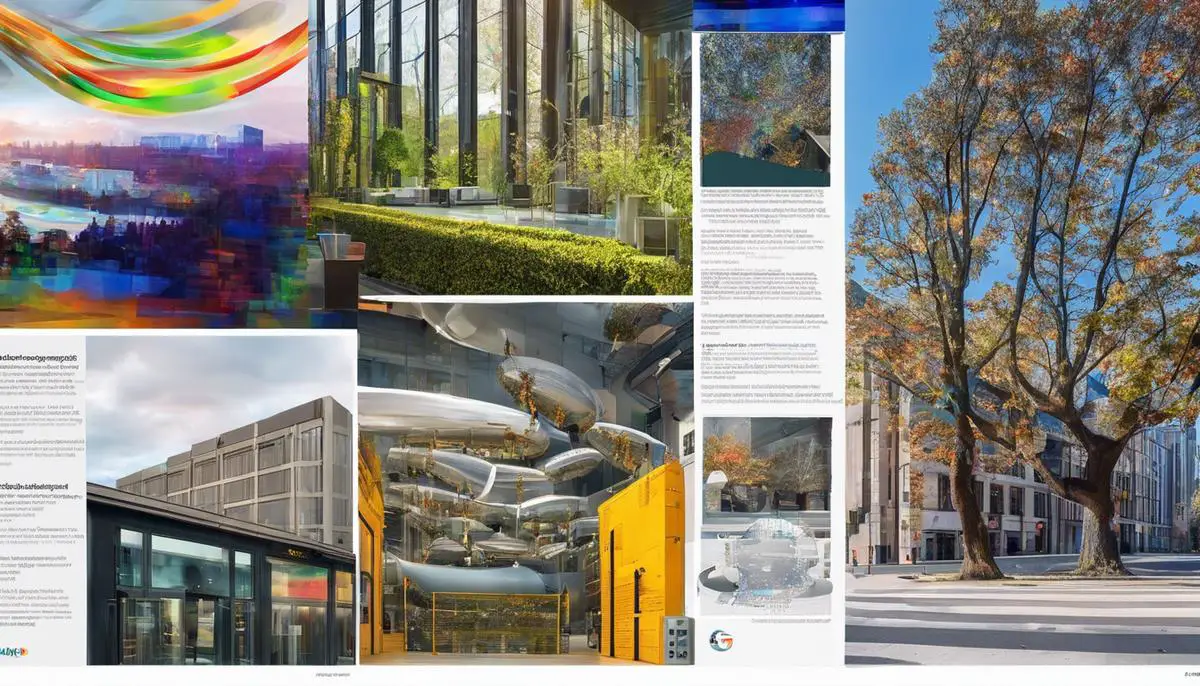Artificial intelligence and machine learning has set a new trajectory in the domain of image synthesis, particularly with the adoption of Generative Adversarial Networks (GANs). GANs constitute an impactful element in synthesizing high-resolution images, which possess the potential to redraw how we interact with digital imagery comprehensively. This discourse delves into understanding the fundamentals of GANs, their architecture, and the pivotal role they play in high-resolution image synthesis. We also unravel the complexities that halt progress in this realm, propose potential solutions and shed light on real-world manifestations of high-resolution GANs. As we traverse through this journey of exploration, the vision of transcending boundaries of digital imagery through GANs becomes visibly credible.
Contents
Understanding Generative Adversarial Networks (GANs)
The world of artificial intelligence (AI) is fascinating with its profound transformations and advancements, offering infinite potential. Among these advancements, Generative Adversarial Networks (GANs) represent a significant leap forward. A GAN is a class of machine learning frameworks, and it’s power resides in its ability to generate new, previously unseen instances of data from existing data sets – a capability that’s been described as enabling machines to “dream.”
The GAN architecture consists of two primary components – a Generator and a Discriminator. These two are aucuately labelled as adversaries, engaging in a kind of strategic competition. This adversarial process, intriguing and unique, is indeed the heart of a GAN.
The Generator’s role can be analogized to a counterfeiter trying to make fake currency that looks authentic. It starts with a random noise (usually represented by a vector) and then applies multiple transformations like convolution and upsampling operations, creating an image as an output. The main task of the Generator is to create data that are akin to the real data.
Contrarily, the Discriminator plays the part analogous to a policeman trying to identify the counterfeited currency. The Discriminator analyses both real data (from the original dataset) and fake data (created by the Generator), and tries to determine if the data is real or fake.
The pair continuously spar, with each trying to outwit the other. The Generator tries to produce data so realistic that the Discriminator can’t tell it apart from real data. Conversely, the Discriminator continuously improves its ability to differentiate between real and fake data. This resonates a simultaneous two-player game where the objective is to outsmart the opponent.
This adversarial process aims to reach what mathematicians call a Nash Equilibrium — a state in game theory where neither player can benefit from changing their strategy unilaterally. When a GAN reaches this state, it signifies that the Generator is producing data indistinguishable from the real data, and the Discriminator can’t tell the difference between the two.
Applications of GANs are as diverse as they are impactful. For instance, in the field of cosmology, scientists use GANs to create models of the universe. In entertainment, GAN technology is being used to create stunning visual effects and photorealistic art. Even in healthcare, GANs are empowering machines to design new drugs and predict the efficacy of medical treatments.
As with any powerful technology, GANs aren’t without challenges. The adversarial nature of GANs makes them hard to train and fine-tuning them is often considered being more of an art than science. Addressing these drawbacks, while striving to maximize their potential, is a challenge the research community is keenly focusing on. Exploration, after all, is about breaking barriers and embracing what lies beyond.
Undeniably, the field of Generative Adversarial Networks offers an intriguing lens to view the rapid evolution of artificial intelligence. This novel architecture, with its unique ability to create from the old and learn from its duels, embodies the captivating confluence of creativity and combativeness. It is a powerful testimony to humankind’s relentless pursuit of artificial intelligence and the delightful surprises it unfurls.

High-Resolution Synthesis with GANs
In furthering the understanding of Generative Adversarial Networks (GANs), the application of these systems in creating high-resolution images holds a distinct position. This article aims to elucidate the workings, potential ramifications and amazing scope of GANs in this particular sphere.
To delve into the creation process of high-resolution images with GANs, it is crucial to discuss the vital role of the Super Resolution GANs (SRGANs) – a specialized type of GAN that specifically caters to image enhancement. Essentially, their major function involves transforming low-resolution input into high-resolution output. They achieve this by learning the mapping between low and high-resolution images, mimicking the image production process in a manner akin to an artist studying and trying to replicate a masterpiece.
An enlightening study, ‘Photo-Realistic Single Image Super-Resolution Using a Generative Adversarial Network’ by Ledig et al. (2017), demonstrates a detailed application of SRGANs. In the study, the lower quality image (low-resolution) constitutes the ‘noise’ that the Generator uses to form a high-resolution version. Successively, the Discriminator then adjudges the quality of this higher-resolution output. If the generated image is indistinguishable from a real high-resolution image, then the Generator is deemed successful and the training cycle is complete.
Within this process, two major elements are crucial for success: perceptual loss and adversarial loss. Perceptual loss ensures that the high-resolution image generated by the GAN retains the structure and content of the original image, improving the image’s quality without changing its core information. On the other hand, adversarial loss creates the necessary competition between the Discriminator and the Generator. This leads to the creation of images that look incredibly realistic while ensuring the efficient functionality of the system in its entirety.
The implications of GANs in creating high-resolution images are profound and wide-reaching. From the realms of medical imaging for diagnostics and treatment planning, to visual effects in the entertainment industry and endeavors in space exploration – the potential for GANs to transform our visual world is overwhelming.
However, it must be acknowledged that GANs, for all their exciting capabilities, are not devoid of pitfalls. Issues of overoptimization resulting in the loss of image diversity, or the infamous ‘mode collapse’, remain significant challenges in the ongoing question of GAN stability. Nevertheless, the research community perseveres, dedicating substantial effort to overcoming these hurdles.
As GANs continue to evolve and emerge as an instrumental tool in the progression of artificial intelligence, one can only marvel at the future possibilities of their application in transforming low-resolution experiences into vivid high-definition perspectives. It is both a mark and a measure of our advancement as we explore the horizons of this brave new digital world.

Challenges in High-Resolution Image Generation
In the realm of high-resolution image generation using Generative Adversarial Networks (GANs), several challenges warrant careful consideration moving forward. Their roots are deeply entrenched within the core components and working mechanisms of GANs.
One of the most prominent hurdles is the issue of mode collapse. While these systems are designed to generate diverse outputs, they occasionally fall into the trap of outputting very similar or even identical copies, particularly when generating high-resolution images. This is due to the generator, in its bid to outsmart the discriminator in the adversarial network, learning and producing only a small subset of the data distribution. The discriminator then struggles to differentiate between the real and generated high-resolution images. This leads to reduced diversity in the GAN outputs, a phenomenon known as mode collapse.
Another predicament is the need for enormous computational power and resources. High-resolution images mean a larger number of pixels and a more complex data structure. Consequently, the processing required by GANs for creating such images is substantially massive. Without ample computational capabilities, the efficiency and effectiveness of applying GANs to high-resolution image creation become greatly limited, posing an obstacle for smaller institutions and independent developers.
Training stability is another notable challenge. The confrontational nature of GANs, centered around the Nash equilibrium, can often lead to instabilities during training. The generator and the discriminator are continually attempting to outdo each other, and this tight competition could lead them into a cycle where neither is able to improve, thus disrupting the equilibrium. Achieving this balance can be especially arduous when dealing with high-resolution images due to the requirement of accurately training billions of parameters, exacerbating the instability issues.
GANs can also suffer from problems with gradient descent. Gradient descent is an iterative optimization technique for minimizing a given function, commonly employed in the training of GANs. However, access to gradients is not always granted in all areas of the problem space, leading to potential stagnation or slow convergence of the network during training.
Finally, the question of ethical implications must be addressed. With their capabilities in generating deeply realistic, high-resolution images, GANs can also be misused for deception and misinformation. The credibility of digital visual media could be threatened if the proliferation of synthetic, high-resolution images runs unchecked.
In the face of these challenges, it is evident that the application of GANs in high-resolution image creation is not without its trials. Yet, the promise of GANs and their potential applications cannot be understated. The initial struggles inherent to new technology often drive the most significant strides in research, pushing the boundaries of innovation. Thus, the scientific and academic communities remain focused on advancing our understanding to effectively harness the power of GANs.

Case Studies of High-Resolution GAN
High-resolution image synthesis using GANs has found its notable manifestation in multiple fields such as video game design and film. A breakthrough came with NVIDIA’s introduction of ‘StyleGAN’ in 2018, an algorithm capable of generating high-fidelity, photorealistic images of human faces which were previously unseen. Later, with the introduction of ‘StyleGAN2’ in 2019, even higher-quality results have been obtained.
Some of the glaring issues with the original StyleGAN, such as phase artifacts and unwanted color blobs, were mitigated in StyleGAN2. The architecture of StyleGAN2 replaces the traditional generator with a mapping network and a synthesis network. Besides, adaptive instance normalization (AdaIN) in the generator also contributed significantly to the improvement of image quality.
While StyleGANs have shown great promise in generating realistic images, these advancements do not come without challenges. Achieving high-resolution output remains a resource-intensive task, requiring powerful hardware configurations and vast amounts of training data.
In the face of these challenges, the implementation of Progressive Growing of GANs (or PGGANs) marks an effective approach. These GANs gradually scale up from generating lower resolution images to ultimately producing a high-resolution output. This technique allows the networks to initially detect large, conspicuous features of a target image, and then gradually refine the details as the resolution increases. This method saves considerable computational resources and improves the stability of training.
Yet, despite these advancements, high-resolution image synthesis with GANs is still a formidable pursuit. The notorious problem of mode collapse, wherein the GAN generates only limited types of samples, is aggravated when it comes to high-resolution image generation. Gradient descent, a popular algorithm used in GAN training, also faces issues like vanishing gradients and instability when applied to larger networks necessary for high-resolution outputs.
Moreover, the power of GANs to create high-resolution synthetic images brings about substantial ethical implications. While this capability has remarkable potential for creating realistic virtual environments and enhancing visual experiences, it could also be misused for fabricating convincing deepfakes which distort reality.
Within these circumstances lies an open greenfield for researchers to unweave more from the realm of GANs for high-resolution image synthesis. Tackling these challenges and uncovering new frontiers of possibilities surges the exhilaration of this exploratory journey in artificial intelligence. As determined troubleshooters refine the existing methods and innovate new techniques, we stride closer to shaking off the limitations and maximizing the potential of GANs in this domain.

Future Directions for GANs in High-Resolution Image Synthesis
The fascinating domain of Generative Adversarial Networks, or GANs, holds significant promise in the scope of high-resolution image synthesis. Exciting advancements such as NVIDIA’s inception of StyleGAN and its refined successor, StyleGAN2, mark a new epoch in this field. These innovative models, particularly StyleGAN2, showcase a leap forward, manifesting an impressive quality of image generation without compromising the resolution.
Pivotal to high-resolution image synthesis is the concept of Progressive Growing of GANs (PGGANs). The PGGANs approach methodically escalates the resolution of images generated from noise vectors, significantly mitigating the training process’s issues. This procedural growth of GANs is a breakthrough development, steering the generation of incredibly realistic images even at highly escalated resolutions.
Despite the substantial potential wellsprings, GANs in the domain of high-resolution image generation are infamous for infamous issues. Struggles with mode collapse, where the generator produces limited varieties of samples, still present considerable challenges. Furthermore, complications with vanishing gradients and instability during training are considerable obstacles, needing the research community’s attention critically.
On the flip side, which is worth discussing, lies the ethical implications associated with high-resolution image synthesis through GANs. GANs’ ascendancy has inadvertently given rise to concerns regarding the creation of deepfakes. These are disturbingly convincing and maliciously forged images and videos that perceptibly blur the line between authenticity and artificiality. Consequently, the ethics of deploying GANs in high resolution synthesizing ventures warrants grave considerations.
To conclude, the hitherto advancements in GANs, and their deployment for high-resolution synthesis, offer astounding prospects. However, facing the challenges of training instabilities, mode collapse, and ethical quandaries remains paramount. But through this labyrinth of hindrances, the future of GANs appears promising indeed. The potential for further research, refinements, and novel applications in this sphere is virtually boundless, and stands as an enticing invitation to the research community, truly serving to underscore GANs’ potential to transform our interaction and perception of synthetic artificial imagery.

Generative Adversarial Networks, in their ability to manifest high-resolution images with intricate detail and accuracy, have already sown the seeds of a revolution in computations and visualizations. As we grapple with persistent challenges such as mode-collapse and training difficulties, the industry and academia’s relentless pursuit of the perfect solution ignites hope. The possibility of near-perfect GANs doesn’t seem far fetched considering the rapid pace of advancements and explorations in this domain. Case studies of high-resolution GANs authenticate the technology’s potential, tracing its impact across diverse sectors. As our understanding and competency with high-resolution GANs deepen, we stand on firm grounds to believe that the future holds infinite prospects for GANs in redefining our conception of digital imagery and simulation.

Emad Morpheus is a tech enthusiast with a unique flair for AI and art. Backed by a Computer Science background, he dove into the captivating world of AI-driven image generation five years ago. Since then, he has been honing his skills and sharing his insights on AI art creation through his blog posts. Outside his tech-art sphere, Emad enjoys photography, hiking, and piano.
